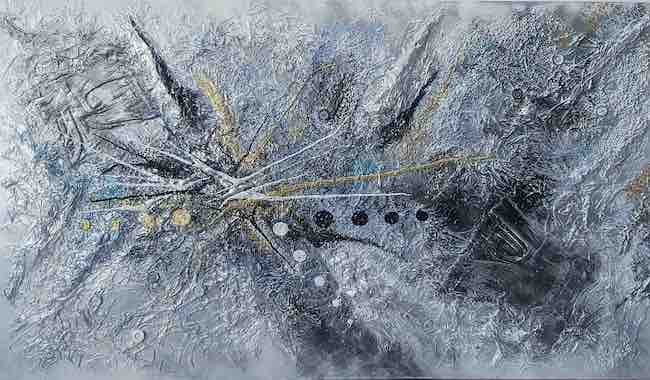Il desiderio di lasciare la parola a quel mondo interiore che preme per fuoriuscire dalle pieghe del pragmatismo appartenente al vivere quotidiano, induce alcuni artisti ad allontanarsi dall’immagine conosciuta poiché potrebbe distogliere lo sguardo dall’attenzione alle emozioni e alle sensazioni che vanno oltre la forma esteriore, il riconoscibile non collegato alle profondità bensì solo alla superficie. A volte la bidimensionalità della tela diviene addirittura insufficiente a dare rilevanza a un universo emozionale ricco e intenso, inducendo pertanto gli autori di un’opera a cercare una maggiore consistenza e solidità attraverso la materia. L’artista di cui vi racconterò oggi crea le sue tele con una tecnica mista con cui sembra incidere le sensazioni percepite che comunicano direttamente con le corde interiori dell’osservatore.
Quando le correnti dei primi decenni del Novecento terminarono la loro funzione sperimentatrice, in particolar modo nel caso di tutti i movimenti astrattisti che vollero fortemente distaccarsi non solo dalla figurazione e dall’immagine riconoscibile dallo sguardo ma anche da tutto quell’universo fatto di sensazioni o di riflessioni riconducibili all’essere umano e alla soggettività dell’esecutore dell’opera, cominciarono a emergere nuove interpretazioni delle stesse e soprattutto evoluzioni in virtù delle quali l’arte, intesa nel senso più tradizionale del termine, venne stravolta e proiettata in un approccio inedito in cui introdurre la terza dimensione, non più limitata solo alla scultura bensì integrata anche all’interno delle tele. I pionieri di questo modo di fare arte, sebbene in loro ciò che emergeva era il sarcasmo quasi dissacrante nei confronti del Classicismo e delle regole accademiche, furono i Dadaisti che utilizzarono il collage applicato sulla tela mescolato all’intervento pittorico, seguiti subito dopo dagli esponenti del Nouveau Réalisme, entrambi però ancora fortemente legati alla figurazione. Tuttavia la strada verso la sperimentazione e l’introduzione sulla di elementi diversi dalla pura pittura era stata aperta e poco dopo, intorno agli anni Cinquanta, sulla scia del successo dell’Espressionismo Astratto statunitense in cui era stato recuperato il contatto con l’emozione e il sentire interiore dell’autore dell’opera, si affermò in Italia il movimento Informale Materico che ebbe come maggiore esponente Alberto Burri. Le emozioni esplodevano violente nelle sue tele in cui protagonista assoluta era la materia, insolita, inedita, modificata, bruciata, incollata sulla base del messaggio che l’artista intendeva esprimere. La sua impetuosità espressiva si affiancò però ad altri modi di interpretare l’Informale Materico, che spesso si spostarono poi verso ulteriori movimenti, come l’Arte Povera, in cui materiali di riciclo, lavorazioni di scarto, elementi che terminavano il loro ciclo di vita e di utilizzo, divenivano parti integranti di opere d’arte in cui la riflessione e il concetto prevalevano sull’istinto esecutivo. Tra i grandi maestri di quello stile di congiunzione tra i due estremi, vi fu il catalano Antoni Tàpies che introdusse l’ascolto della materia come elemento fondamentale per percepire, più che capire, le sue opere fatte di cemento, tele, sabbia, terra, corde, e che con il suo percorso innovativo e solitario, non aderì mai infatti ad alcun gruppo pittorico, aprì la strada alla generazione successiva di artisti che scelsero di esprimere i loro messaggi interiori attraverso la mescolanza tra pittura e interazione con la terza dimensione, eseguendo opere in rilievo che sottolineano la concretezza delle sensazioni percepite. L’artista lombardo Paolo Boscolo, con l’autonomia espressiva che contraddistingue le generazioni contemporanee, reinterpreta l’intento originario di Tàpies introducendo materiali inediti ma restando più vicino, dal punto di vista espressivo, all’istintualità degli espressionisti astratti a cui però non può fare a meno di legare la concretezza di elementi di uso quotidiano o appartenenti alla natura, in qualche modo avvicinandosi dunque all’Arte del Riciclo ma anche all’Arte Povera.
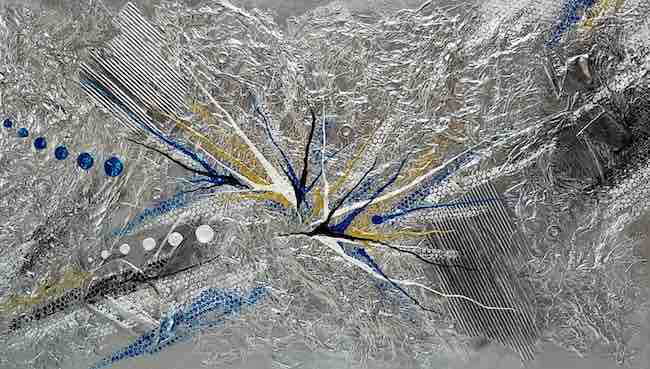
Ciò che emerge in maniera chiara e inequivocabile è la sensibilità dell’artista che si pone in profondo ascolto di tutte quelle energie che ruotano intorno all’essere umano senza che quest’ultimo sia in grado di percepirle, nella maggior parte dei casi; Boscolo si fa così interprete e rivelatore delle voci sottili delle cose e dei concetti che tanto fondanti erano nelle opere di René Magritte e che possono fuoriuscire anche attraverso un approccio pittorico completamente discostante dalla realtà osservata.
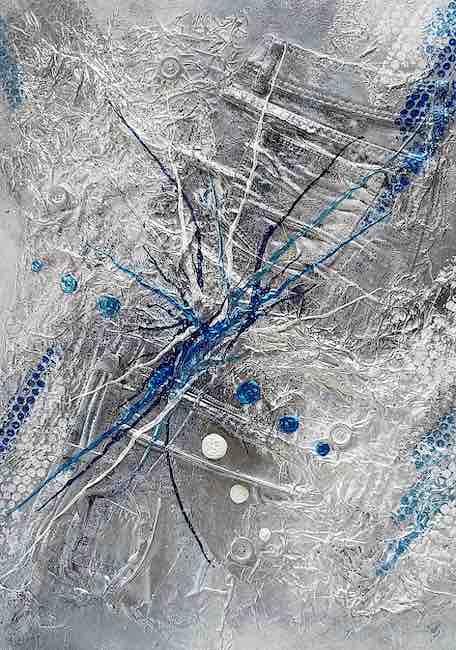
I titoli divengono dunque indicativi di tutto quel mondo di percezioni che appartiene all’approccio alla vita di Paolo Boscolo, quasi fossero una traccia, uno spunto di riflessione per il fruitore della tela che viene prima conquistato in virtù dell’impatto visivo, dell’esplosione di forme intersecanti che irrompono sugli sfondi prevalentemente in scala di grigi, e poi viene indotto a meditare sul senso più profondo, su quel messaggio intellettivo che lo stimola a lasciarsi guidare dall’artista alla considerazione di aspetti e di argomenti troppo spesso tralasciati nel vivere quotidiano. Ma la caratteristica più distintiva è l’introduzione nella tela di materiali inaspettati e che contribuiscono a costituire quell’elemento di rottura, quella scossa necessaria ad accendere la coscienza e a scuotere il grigio per ricondurre l’individuo al contatto con un sé più interiore; carta, terra, sassi, jeans, cartone, stracci, bottoni che vengono trasformati rispetto alla loro forma originaria e arricchiti con colori metallizzati che infondono alle opere quell’aspetto magnetico e affascinante in grado di conquistare prima lo sguardo e poi l’anima.
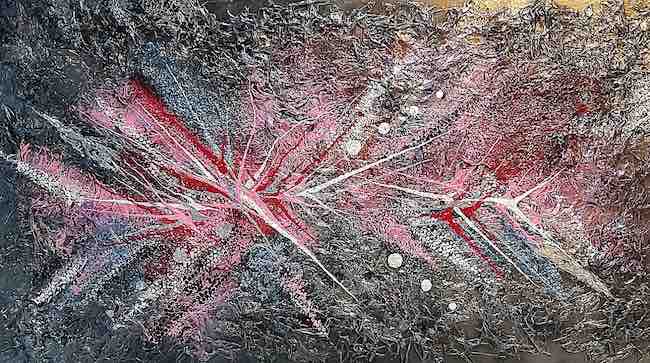
L’opera Femminilità appare come una celebrazione di quell’universo misterioso e incomprensibile che rappresenta tutto ciò che l’uomo non riesce ad avere, la sensibilità, la morbidezza, l’empatia raccontate da Boscolo con quel rosa che sembra squarciare il buio della razionalità, appartenente di contro alla natura maschile, e che sottolinea l’ammirazione da parte dell’artista verso il fascino femmineo e al tempo stesso la capacità di riconoscere l’importanza del ruolo della donna nella società di ogni tempo. La delicatezza di quelle striature pittoriche che emergono dalle increspature della carta, dalla ruvidità dei sassi e della terra, è resa più brillante e lucente dal tocco metallico dell’argento, che evidenzia e pone in primo piano la preziosità dell’universo accogliente ed emotivo che appartiene all’essenza femminile.
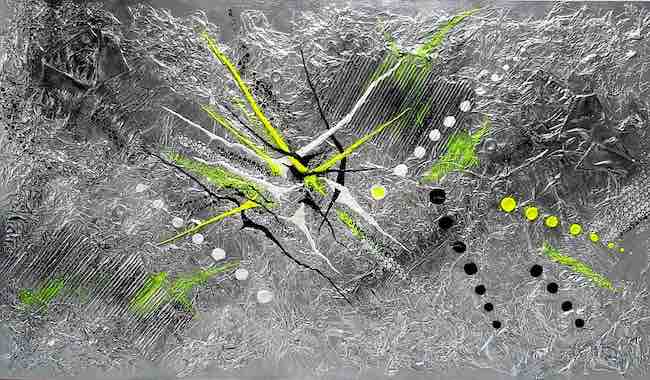
In Estate invece Paolo Boscolo sposta la sua attenzione verso un concetto più universale, quello cioè della capacità della natura di influenzare l’umore dell’individuo, di definirne l’approccio alla vita sulla base dell’alternanza tra luce e buio trasformando così la vita in un momento più piacevole e divertente, esattamente come accade in estate. L’allegria e la spensieratezza sembrano fuoriuscire dalla tela attraverso le tonalità gialle del sole e verdi dei fili d’erba che si rivitalizzano nei mesi più caldi, conquistando lo sguardo dell’uomo che si sente travolto dalla bellezza, dalla possibilità di trascorrere più tempo all’aria aperta, di approfittare delle giornate più lunghe e delle vacanze dopo mesi di duro lavoro. Dunque, malgrado il tratto fortemente distintivo delle sue opere, Paolo Boscolo riesce a modificare il suo lirismo di tela in tela, talvolta rendendolo più poetico, in altri casi lasciando emergere la vitalità, e poi in alcuni esplorando invece l’aspetto più interiore, più connesso con un punto di vista personale e introspettivo che funge da stimolo introspettivo per l’osservatore.
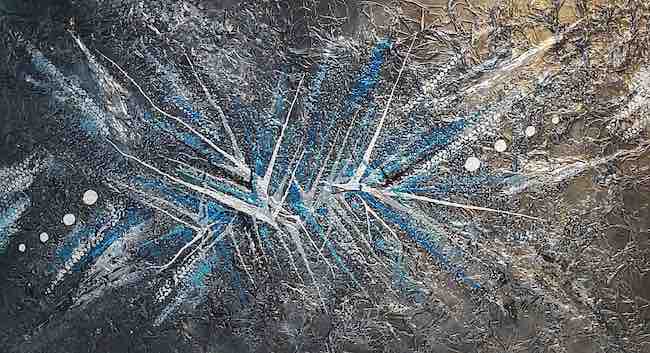
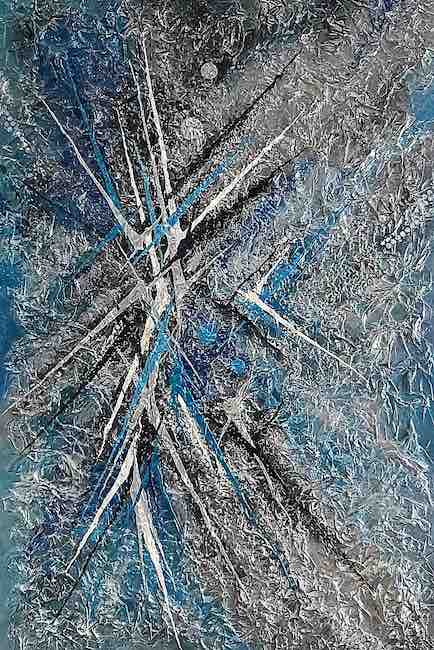
In Respiro e Vento infatti, l’artista sembra lasciarsi avvolgere e travolgere dall’esigenza di prendersi una pausa, un momento per se stesso all’interno del quale ascoltare le proprie sussurrate richieste interiori che a volte solo attraverso il silenzio è possibile lasciar parlare, sentendone il battito leggero, il pulsare silenzioso che si uniforma al ritmo di un sentire spesso ignorato perché perso dentro il rumore della vita, di quel dover correre e realizzare trascurando di essere. Quella di Boscolo dunque è un’esortazione a non dimenticare di fermarsi, di sedersi per trovare il necessario contatto con il proprio sé, per collegarsi con la propria naturalità ma anche con quella esterna che spesso diviene guida di ciò che l’uomo non è più in grado di ricordare.
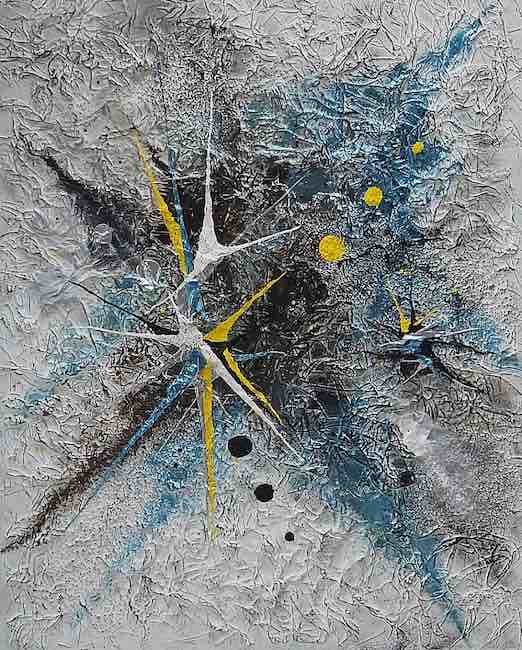
Il contatto con la natura è essenziale per ricordarsi della semplicità, di quanto la vita possa essere più leggera e al tempo stesso più intensa se si ritorna a un approccio più primordiale e naturale, almeno nel momento in cui si rimane soli con se stessi e non è più necessario proteggersi dall’esterno. Paolo Boscolo ha al suo attivo molte mostre personali e collettive su tutto il territorio nazionale, riscuotendo grande successo di pubblico e l’attenzione degli addetti ai lavori.
PAOLO BOSCOLO-CONTATTI
Email: boscolo.art@gmail.com
Sito web: https://www.pboscoloart.it/
Facebook: https://www.facebook.com/paolo.boscolo.330
Instagram: https://www.instagram.com/pboscolo_art/
Emotions, fantasies and energies in Paolo Boscolo’s Materic Informal
The desire to give a word to that inner world that presses to escape from the folds of the pragmatism belonging to everyday life, induces some artists to move away from the known image because it could distract their gaze from the emotions and sensations that go beyond the external form, the recognisable not connected to the depths but only to the surface. Sometimes the two-dimensionality of the canvas even becomes insufficient to give relevance to a rich and intense emotional universe, thus inducing the authors of an artwork to seek greater consistency and solidity through matter. The artist I will tell you about today creates his canvases with a mixed technique with which he seems to engrave perceived sensations that communicate directly with the observer’s inner chords.
When the currents of the first decades of the 20th century ended their experimental function, especially in the case of all the abstractionist movements that wanted to strongly detach themselves not only from figuration and the image recognisable to the eye, but also from all that universe made up of sensations or reflections traceable to the human being and the subjectivity of the artwork’s executor, new interpretations of the same began to emerge, and above all evolutions in virtue of which art, intended in the most traditional sense of the term, was turned upside down and projected into an unprecedented approach in which was introduced the third dimension, no longer limited to sculpture alone, but also integrated within canvases. The pioneers of this way of making art, although what emerged in them was an almost desecrating sarcasm towards Classicism and academic rules, were the Dadaists who used collage applied to canvas mixed with pictorial intervention, followed soon after by the exponents of Nouveau Réalisme, both of whom were still strongly linked to figuration. However, the road towards experimentation and the introduction of elements other than pure painting had been paved and shortly afterwards, around the 1950s, in the wave of the success of American Abstract Expressionism in which contact with the emotion and inner feeling of the author of the artwork had been recovered, the Materic Informal movement established itself in Italy with Alberto Burri as its major exponent.
Emotions exploded violently in his canvases in which the absolute protagonist was matter, unusual, modified, burnt, glued on the basis of the message the artist intended to express. His expressive impetuosity, however, went hand in hand with other ways of interpreting Materic Informal, which often moved on to other movements, such as Arte Povera, in which recycled materials, discarded work, elements that were at the end of their life cycle and use, became integral parts of the artwork in which reflection and concept prevailed over executive instinct. Among the great masters of that style of joining the two extremes was the Catalan Antoni Tàpies who introduced listening to matter as a fundamental element to perceive, rather than understand, his works made of cement, canvases, sand, earth, ropes, and who with his innovative and in fact solitary path, he never belonged to any painting group, paved the way for the next generation of artists who chose to express their inner messages through a mixture of painting and interaction with the third dimension, executing artworks in relief that emphasise the concreteness of perceived sensations. The Lombard artist Paolo Boscolo, with the expressive autonomy that distinguishes contemporary generations, reinterprets Tàpies’ original intent by introducing new materials but remaining closer, from an expressive point of view, to the instinctuality of the abstract expressionists, to which, however, he cannot fail to link the concreteness of elements of everyday use or belonging to nature, thus in some way approaching the Art of Recycling but also Arte Povera.
What emerges clearly and unequivocally is the sensitivity of the artist who listens deeply to all those energies that revolve around the human being without the latter being able to perceive them, in most cases; Boscolo thus becomes the interpreter and revealer of the subtle voices of things and concepts that were so fundamental in the works of René Magritte and that can also emerge through a pictorial approach that is completely different from the reality observed. The titles thus become indicative of that entire world of perceptions that belongs to Paolo Boscolo’s approach to life, almost as if they were a trace, a food for thought for the viewer of the canvas who is first won over by virtue of the visual impact, the explosion of intersecting forms that burst against the predominantly grey scale backgrounds, and is then induced to meditate on the deeper meaning, on that intellectual message that stimulates him to let the artist guide him to the consideration of aspects and topics too often overlooked in daily life. But the most distinctive feature is the introduction of unexpected materials into the canvas that contribute to constitute that element of rupture, that necessary shock to ignite the conscience and shake the greyness to bring the individual back into contact with a more interior self; paper, earth, stones, jeans, cardboard, rags, buttons that are transformed from their original form and enriched with metallic colours that infuse the artworks with that magnetic and fascinating aspect capable of conquering first the gaze and then the soul. The work Femininity appears as a celebration of that mysterious and incomprehensible universe that represents all that man cannot have, the sensitivity, the softness, the empathy recounted by Boscolo with that pink that seems to pierce the darkness of rationality, belonging in contrast to the male nature, and which underlines the artist’s admiration for feminine charm and at the same time his ability to recognise the importance of the role of women in the society of all times. The delicacy of those pictorial streaks that emerge from the ripples of the paper, from the roughness of the stones and the earth, is made brighter and shinier by the metallic touch of silver, which highlights and foregrounds the preciousness of the welcoming and emotional universe that belongs to the feminine essence.
In Summer, on the other hand, Paolo Boscolo shifts his attention to a more universal concept, that of nature’s ability to influence the individual’s mood, to define his approach to life on the basis of the alternation between light and darkness, thus transforming life into a more pleasant and enjoyable time, exactly as it happens in summer. Cheerfulness and light-heartedness seem to spill out of the canvas through the yellow hues of the sun and the green of the blades of grass that are revitalised in the warmer months, conquering the gaze of the man who feels overwhelmed by beauty, by the possibility of spending more time in the open air, of taking advantage of the longer days and holidays after months of hard work. Thus, despite the strongly distinctive trait of his aartworks, Paolo Boscolo manages to modify his lyricism from canvas to canvas, sometimes making it more poetic, in other cases allowing vitality to emerge, and then in some exploring the more interior aspect, more connected with a personal and introspective point of view that serves as an introspective stimulus for the observer. In Breath and Wind, the artist seems to allow himself to be enveloped and overwhelmed by the need to take a pause, a moment for himself within which to listen to his own whispered inner requests that sometimes only through silence can be allowed to speak, feeling the light beat, the silent pulsing that conforms to the rhythm of a feeling that is often ignored because it is lost in the noise of life, of that having to run and achieve while neglecting to be. That of Boscolo is therefore an exhortation not to forget to stop, to sit down in order to find the necessary contact with one’s own self, to connect with one’s own naturalness but also with the external one that often becomes the guide of what man is no longer able to remember. Contact with nature is essential to remind oneself of simplicity, of how much lighter and at the same time more intense life can be if one returns to a more primordial and natural approach, at least when one is alone with oneself and no longer needs to protect from the outside world. Paolo Boscolo has many solo and group exhibitions to his credit throughout the country, gaining great success with the public and the attention of experts.


